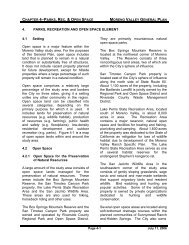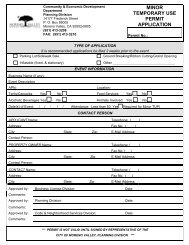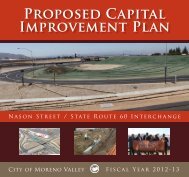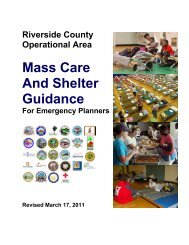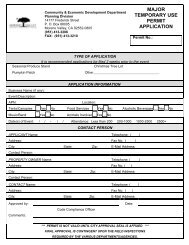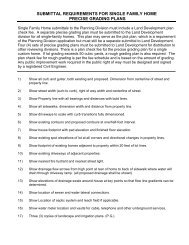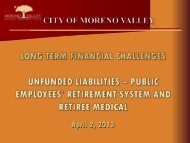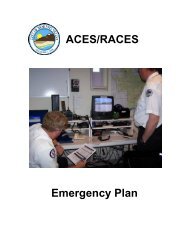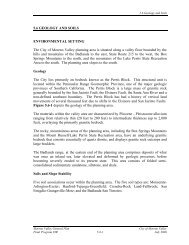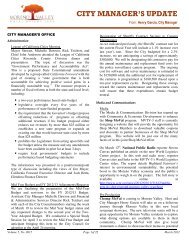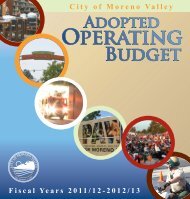General Plan - Moreno Valley
General Plan - Moreno Valley
General Plan - Moreno Valley
Create successful ePaper yourself
Turn your PDF publications into a flip-book with our unique Google optimized e-Paper software.
CHAPTER 6 – SAFETYUpon completion of construction, significantincreases of automobile and truck traffic willoccur, with associated increases inemissions. The third source of pollutantemissions is from stationary sources,primarily resulting from industrial processes.Additionally, energy demands for newdevelopment require the combustion of fossilfuels for space heating and powergeneration. This will create emissions locallyand at distant power plants.Clearing, grading, and travel on unpavedroads will generate fugitive dust. Theamount of dust can generally be reducedthrough the application of control measuressuch as regular watering. Other potentialfugitive dust reduction measures include soilcompaction; early paving, sealing, or oiling ofaccess routes; and enforcement of maximumspeed limits within unpaved portions ofconstruction areas.Fugitive dust will generally settle out onnearby horizontal surfaces such as foliage,vehicles, and buildings. Smaller dustparticles will be carried by the prevailingwinds to more distant locations. Fugitivedust particles are usually inert sillicates, andare large enough to be filtered by humanbreathing passages. Such dust maycontribute to the degradation of visibility inthe area, but typically will not have adversehealth effects, as would the very small,complex organic aerosols of urban airpollution.In addition to fugitive dust, emissions fromheavy equipment and trucks will add to localair pollution. The impacts of constructionactivities are temporary and are primarily anuisance factor.The most local air emissions will result fromadditional vehicle miles traveled due to newlocal development, as well as from increasesin regional traffic along State Route 60 andInterstate 215. Compared to the hundreds ofmillions of vehicle miles already traveled inthe South Coast Air Basin, the effect ofMORENO VALLEY GENERAL PLAN<strong>Moreno</strong> <strong>Valley</strong> area growth will be minimal.However, on a local scale, there may bemicro-scale air quality problems, such ascarbon monoxide concentrations.The number and length of trips occurringwithin the city can be reduced byencouraging a balance between employmentand housing. A jobs/housing balance wouldreduce emissions from long commutes.Zoning property along transit routes to allowhigh-density residential, commercial andemployment-intensive land uses could alsoreduce vehicle trips and miles traveled.Another source of emissions is derived fromthe consumption of electricity and naturalgas. Compared to mobile source emissionsand regional stationary source emissions,local impacts will be minimal. It should alsobe noted that much of the stationary sourceemissions would be generated at distantpower plants.Industrial processes also create stationarysource emissions. The type and quantitiesof these emissions are highly variabledepending on the specific industrial process,materials used and production level.6.7 WATER QUALITY6.7.1. Backgrounda. Groundwater Quality.Although groundwater provides a fraction ofthe local water supply, groundwater is avaluable natural resource that should beprotected. Groundwater aquifers arenatural storage tanks that can store waterfor use during drought periods. Agriculturalchemicals, domestic sewage and chemicalspills are potential sources of groundwaterpollution in the study area.While agricultural operations are no longer amajor source of water pollution, pastoperations contributed to concentrations ofsalts and dissolved solids that createdPage 6-21 July 11, 2006




